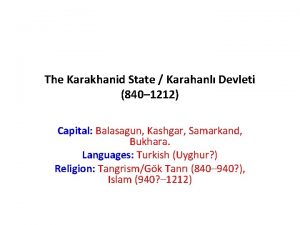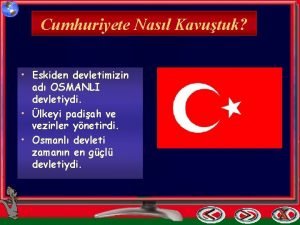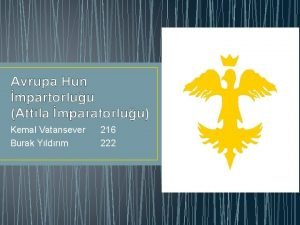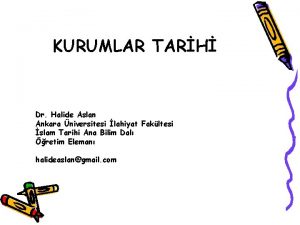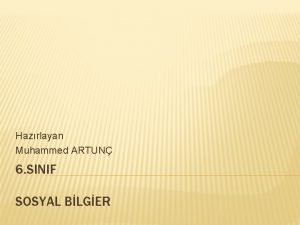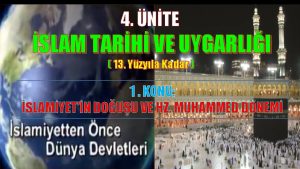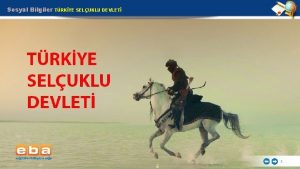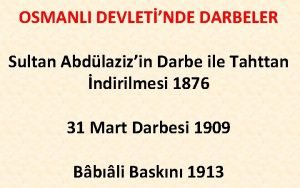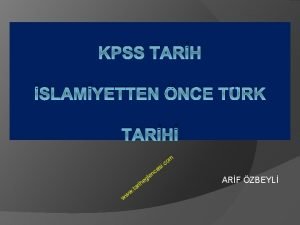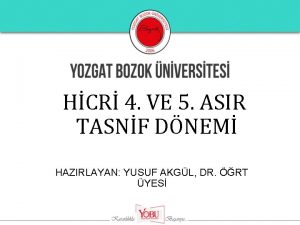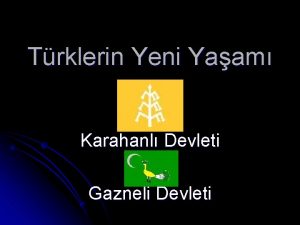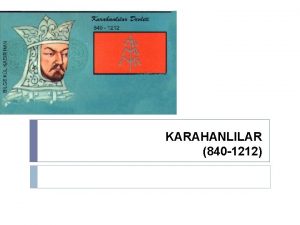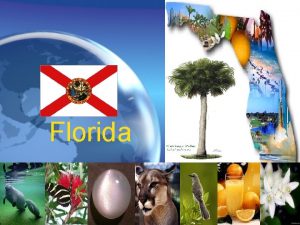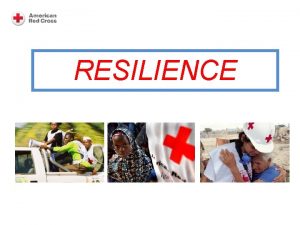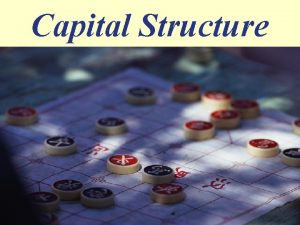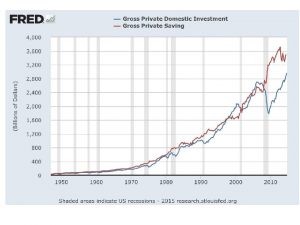The Karakhanid State Karahanl Devleti 840 1212 Capital































- Slides: 31

The Karakhanid State / Karahanlı Devleti (840– 1212) Capital: Balasagun, Kashgar, Samarkand, Bukhara. Languages: Turkish (Uyghur? ) Religion: Tangrism/Gök Tanrı (840– 940? ), Islam (940? – 1212)

Flag of Karakhanids

The Map of Kharakhanids

Lands of Karahanid Dynasty

Lands of Karahanid Dynasty

The name of kara khan • The rulers of the Karakhanids were likely to be from the Chigil and Yaghma tribes of Karluks confederation • the Eastern Khagan bore the title “Arslan Kara Khaqan” (Arslan "lion", the totem of the Chigil) the Western Khagan bore the title “Bughra Kara Khaqan” (Bughra "male camel", the totem of the Yaghma). • After converting Islam the Karahanids adopted Muslim names and honorifics titles sultan and sultān al salātīn (sultan of sultans), while keeping Turkish regnal titles such as Khan, Khagan, Ilek/Ilig and Tegin/Tekin. • In an interpretation; Turkish culture colors point directions. For example “kara” means north, “kızıl” means south, “gök” means east, “ak” means west. Due to establishment in the north of Turkish main land the dynasty was called Karakhanid • The name was devised by Orientalists in the 19 th century namely V. Grigoriev to describe both the dynasty and the Turks ruled by it in 1874.

The Name of Karakhanids • Arabic Muslim sources called this dynasty – al Khaqaniya("That of the Khaqans") or – al Muluk al Khaniyya al Atrak(The Khaghan kings of the Turks) • Persian sources often preferred the term – Al i. Afrasiyab ('House of Afrisyab') on the basis of the legendary kings of pre-Islamic Transoxania, – Ilek Khanids or Ilak Khanids Ilak Kha ni ya n) in Persian.

Foundation of Karahanids • During the 9 th century, the Karluk confederation (including the Tu rgesh descended Chigil and Tukshi tribes) and the Yaghma, possible descendants of the Toquz Oghuz, joined force and formed the first Karluk -Karakhanid khaganate. • The Chigils appear to have formed the nucleus of the Karakhanid army. • The date of its foundation and the name of its first khan is uncertain, but according to one reconstruction, the first Karakhanid ruler was Bilge Kul Qadir Khan. • According to one reconstruction, the first Karakhanid founded in 840.

Conversion of Satuq Bughra Khan (d. 958) • According to Tazkirah Bughra Khan, Satuq converted to Islam when he was twelve. He was taught about Islam by Abu-an-Nasr Samany from Bukhara. Nasr befriended the Khan of Katahanid, Satuq's father (or step-father, or uncle, varies according to different accounts) Oghulchak Kadır Khan, and was granted special dispensation to build a mosque in the town of Artush just outside of Kashgar. • When Satuq saw Nasr and other Muslims observing their daily prayers he became curious and was instructed by them in the Islamic religion. Satuq kept his faith secret from the khan, but convinced his friends to convert. However, when the khan heard that Satuq had become a Muslim, he demanded that Satuq build a temple to show that he hadn't converted. • Nasr advised Satuq that he should pretend to build a temple but with the intention of building a mosque in his heart. The king, after seeing Satuq starting to build the temple, then stopped him, believing that he had not converted. • Afterwards, Satuq obtained a fatwa which permitted him in effect to commit patricide, and killed his uncle, after which he conquered Kashgar.

Tomb of Sultan Satuk Bughra Khan, the first Muslim khan, in Artush, Eastern Turkestan

Analysis of the Motives for the Conversion Although religious fervor/passionate enthusiasm may have motivated Satuq’s actions, an additional reason - ambition for power. To get alliance: The Samanids had followed the Arab Abbasid custom of taking Turks as mamluks and conscripting their warriors into their army. More than a thousand Karakhanids living in Samanid territory had changed religions by nominal freedom. If Satuq voluntarily submitted himself and his followers to Islam, he would easily gain the confidence of the Samanids and seal a military alliance. To unify Turkish tribes: if Satuq had ambitions of his own to stop the Karakhanid losses of territory and forge the Turks into a regional power, his move would be facilitated by unifying his people around a new religion. The combination of Buddhism and Shamanism had failed to provide the supernatural support for his uncle to keep control of his lands across the Tangry Mountains; whereas with Islam behind them, the Samanids had succeeded in gaining the victory. The choice of new religions was obvious. To control trade: In order to rally the Turkish tribes behind his ambition, Satuq needed a religion not only different from Buddhism but also allow him to reopen the alternative southern branch of the Silk route and shift the focus of control of the trade from the eastern to the western sectors.

Propagating Islam by Satuq Bughra • After conversion, he obtained a fatwa which permitted him to dethrone his pagan father and with a military coup he became khan. • He started to propagate Islam among non-muslim the Turkish and other tribes, conquered lands. He was bestowed the title of ghazi. During his lifetime Islam became dominant religion among the Karahanid people. • Thanks to his and his sons’ efforts later in 960, according to Muslim historians Ibn Miskawaih and Ibn al-Athir, there was a mass conversion of the Turks (reportedly "200, 000 tents of the Turks"), circumstantial evidence suggests these were the Karakhanids.

Division of the Karakhanid Khanate (1042) • In the final decade of the 10 th century and onwards, the Karakhanids began a struggle against the Samanids for control of Mawaraunnahr. • The Samanid domains were split up between the Ghaznavids, who gained Khorasan and Afghanistan, and the Karakhanids, who received Mawaraunnahr; the Oxus River thus became the boundary between the two rival empires. • Early in the 11 th century the unity of the Karakhanid dynasty was fractured by frequent internal warfare that eventually resulted in the formation of two independent Karakhanid states between two brothers in 1042: – the Eastern Karahanids, its capital at Balasaghun and later Kashgar, – the Western Karahanids, its capital Bukhara. • The Ferghana-Semirechye areas became the border between the two states and were frequently contested.

Seljuk suzerainty on the Kharakhanids 1089 • The Western Karakhanids, namely Ahmad Khan, developed serious conflicts with the ulama. In 1089 at the request of the sadrs / ulama of Mawaraunnahr, the Seljuks entered and took control of Samarkand, the Western Karakhanids became a vassal of the Saljuks for half a century. • The Eastern Karakhanids also declared their submission following a Seljuk campaign into Talas and Semirechye. • But at the beginning of 12 th century they invaded Mawarauunahr and even occupied the Seljuk town of Termez for a time.

Kara Khitan /Khitay Invasion of Karakhanids 1137 • The Kara Khitans were a Mongolian people. They occupied Balasagun, then defeated the Western Karakhanids in Khujand in 1137 • The Kara Khitans, however, did not destroy the Karakhanid dynasty. Instead, they stayed at Semirechye near Balasaghun, and allowed some of the Karakhanids to rule as vassals in Samarkand Kashgar.

Downfall • The decline of the Seljuks allowed the Khwarezmids, to expand into former Seljuk territory. • In 1212, the population of Samarkand staged a revolt against the Khwarezmians. The Khwarezm-Shah returned, recaptured Samarkand; demanded the submission of all leading Karakhanids, and finally extinguished the Western Karakhanids. • The Eastern Karahanids survived until 1211 and then accepted the sovereignty of the Great Seljuk State. Later, they would serve both the Kara Khitani to the north and the Seljuks to the south.

The Karahanid Culture 1 • Islam and its civilization flourished: One earliest example of madrasas in Central Asia was founded in Samarkand by Ibrahim Tamghach Khan. He also founded a hospital to care for sick as well as providing shelter for the poor. His son Nasr Shams al-Mulk built ribats for the caravansarais on the route between Bukhara and Samarkand, and a palace near Bukhara. Some of the buildings still survive - for example the Kalyan Minaret built by Mohammad Aslan Khan beside the main mosque in Bukhara, and three mausoleums in Uzgend. • The Turkish identity is evident in both of these pieces of work by the influences of Persian and Islamic culture. However, the court culture of the Karakhanids remained almost entirely Turkish.

Rıbat-ı Malik of Karakhanid’s summer residance

Karakhanid monuments in Uzgen

Kalyan Minaret in Bukhara

The Karakhanid Culture 2 • Turkish Islamic language and culture flourished: The official or court language used in Kashgar and other Karakhanid centers, referred to as "Khaqani" (royal), remained Turkish. • The Turkish script was also used for all documents of khaqans. • The Dīwānu’l Luġat al Turk • Kutadgu Bilig • Divan al-Hikmah of Yasawi • The Epic of Manas (Manas Destanı) is a traditional epic poem dating to the 12 th century, primarily the interaction of the Turkish people mainly Kyrgyzs from the mountains to the south of the Dasht-i Qipchaq and the Oirat Mongols from the bordering area of Jungaria. • Tazkirah Bughra Khan (Memory of Bughra Khan). Satuq Bughra’s conversion tp Islam also orally transmitted

Di wa n Lugha t al Turk • Al-Kashgari studied the Turkic languages of his time and in Baghdad he composed the first comprehensive dictionary of Turkic languages, the Di wa n Lugha t al Turk( Compendium of the languages of the Turks) in 1072 -74. • It was intended for use by the Abbasid Caliphate, the new, Arab allies of the Turks. • Mahmud Kashgari's dictionary, later edited by the Turkish historian, Ali Amiri, contains specimens of old Turkic poetry in the typical form of quatrains (ruba 'iya t; do rtlu k), representing all the principal genres: epic, pastoral, didactic, lyric, and elegiac. • His book also included the first known map of the areas inhabited by Turkic peoples. This map is housed at the National Library in Istanbul.

World Map of Kashghari


Divan-ı Lugat’it-Turk

The Kutadgu Bilig Written by Yusu f Kha s s H a jib for the prince of Kashgar and presented to Tavghach Bughra Khan, the prince of Kashgar in 462 (1069/1070 AD) "The Wisdom which brings Happiness" or "The Wisdom that Conduces to Royal Glory or Fortune”, "Wisdom Which Brings Good Fortune”. The text reflects the author's and his society's beliefs, feelings, and practices with regard to quite a few topics, and depicts interesting facets of various aspects of life in the Karakhanid empire. Structured around the relations between four main characters, each representing an abstract principle (overtly stated by the author). Name Translation Occupation Principle küntog dı "the sun has risen" / Rising king Sun Justice aytoldı "the moon is full" / Full Moon vizier Fortune ögdülmis "praised" / Highly Praised sage Intellect (or Wisdom) oðg urmıs "awakened" / Wide Awake Dervish Man's Last End

Kutadgu Bilig

Diwan al-Hikmah

Atabetu’l-Hakayık

Heritage of the Krakhanids Muslim Turkish literature was developed in the Karahanids. The State, was customarily governed by just, religious, and culture Kashgar and Balasagun became important cultural centers. From the 9 th century onwards, the Turks (at least individually, if not yet through adoption by their states) began to convert to Islam. • The Karluk dialect spoken by the nomadic tribes and Turkified sedentary populations under Karakhanid rule branched out into two major branches of the Turkish language family, the Chagatay and the Kypchak. • The Chagatay, Timurid and Uzbek states and societies inherited most of the cultures of the Karakhanids and the Khwarezemians without much interruption. • •

The Krakhanids attacking to the Samanids 998
 The karakhanid state
The karakhanid state Escuela 1212 sunchales
Escuela 1212 sunchales Xxxx 1212
Xxxx 1212 A word 1212
A word 1212 The cable of the tower crane is subjected to 840
The cable of the tower crane is subjected to 840 Rozklad čísla 840 na součin prvočísel
Rozklad čísla 840 na součin prvočísel Setengah lusin sepatu dibeli dengan harga 4
Setengah lusin sepatu dibeli dengan harga 4 Gl 840
Gl 840 Envirolastic 840
Envirolastic 840 Seorang pedagang membeli 3 kodi pakaian dengan harga
Seorang pedagang membeli 3 kodi pakaian dengan harga A trader mixes 26 kg of rice
A trader mixes 26 kg of rice Hukuk devleti nedir
Hukuk devleti nedir Hukuk devleti nedir
Hukuk devleti nedir Cumhuriyetten önceki devletimizin adı neydi
Cumhuriyetten önceki devletimizin adı neydi üstün emretme ayrıcalığı
üstün emretme ayrıcalığı Avrupa hun devleti margos antlaşması
Avrupa hun devleti margos antlaşması 753-509 a.c
753-509 a.c Devleti aliyye
Devleti aliyye Orhun bölgesi
Orhun bölgesi Kavimler göçünden sonra kurulan ilk türk devleti
Kavimler göçünden sonra kurulan ilk türk devleti Asya hun devleti kurucusu
Asya hun devleti kurucusu Abbasilerde devletin mali işlerine bakan divan kimdir
Abbasilerde devletin mali işlerine bakan divan kimdir Idil volga türkleri
Idil volga türkleri Cu devleti
Cu devleti Seba devleti
Seba devleti Yassıçemen savaşı önemi
Yassıçemen savaşı önemi Darbelerin kaybettirdiği topraklar
Darbelerin kaybettirdiği topraklar Itil volga bulgar devleti nerede kuruldu
Itil volga bulgar devleti nerede kuruldu Tasnf
Tasnf Introduction of working capital
Introduction of working capital Difference between capital reserve and reserve capital
Difference between capital reserve and reserve capital Multinational capital structure
Multinational capital structure
